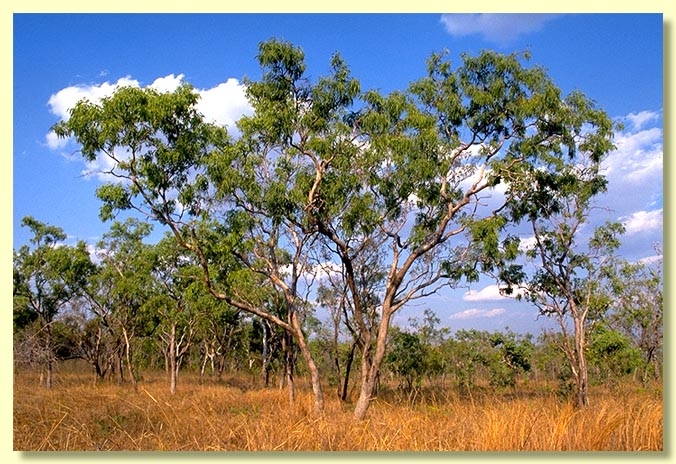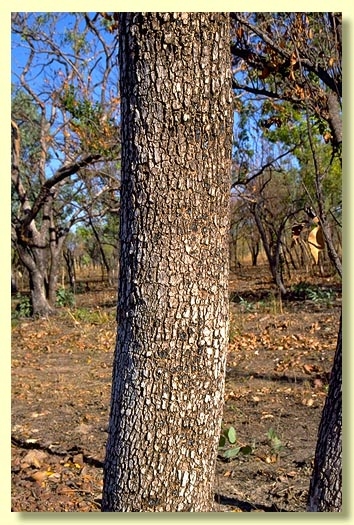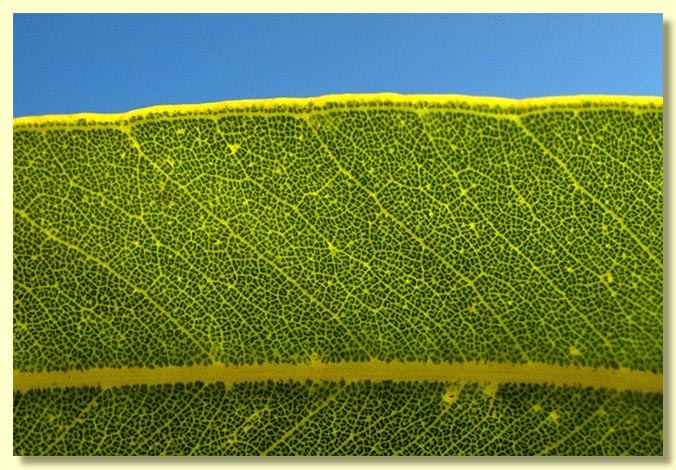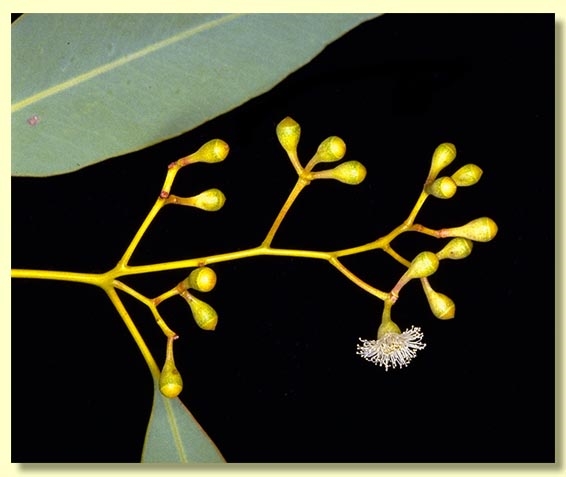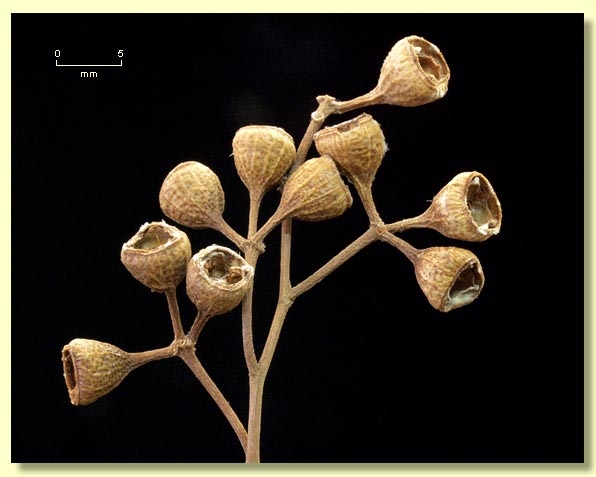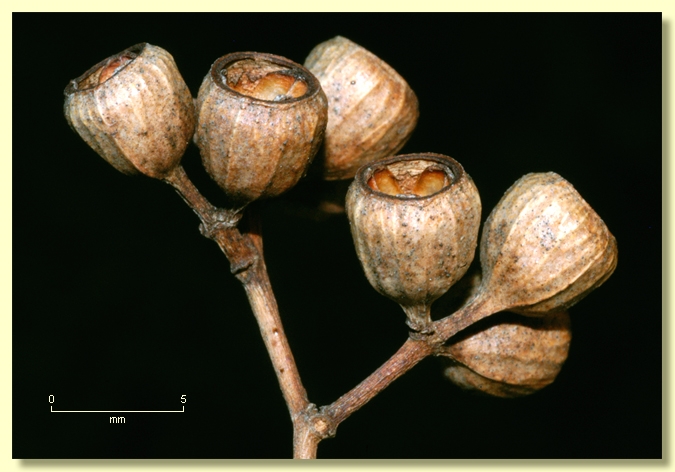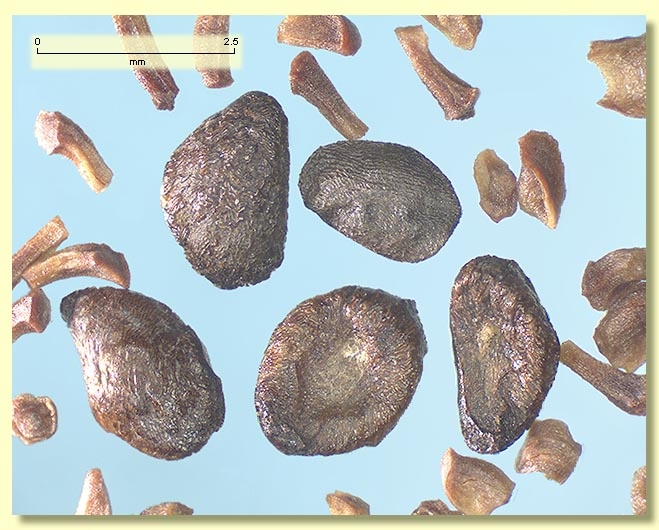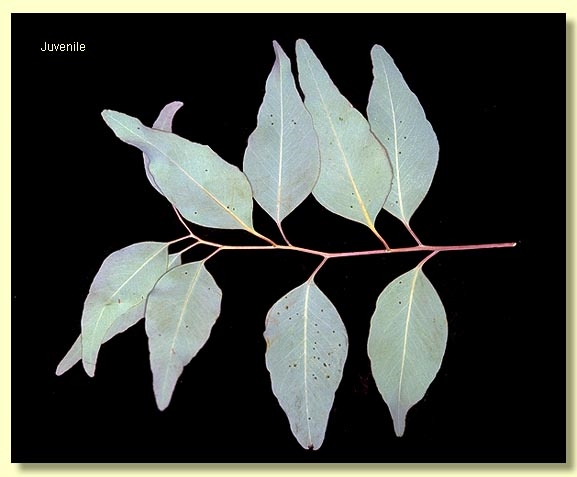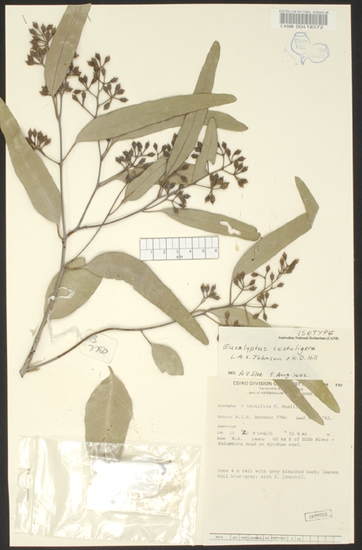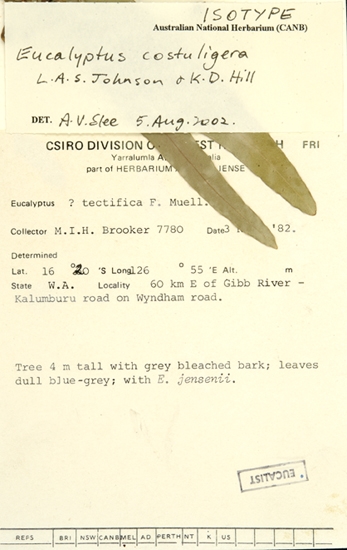Eucalyptus | Symphyomyrtus | Adnataria | Apicales | Aquilonares | Protrusae
Euclid - Online edition
Eucalyptus tectifica
Eucalyptus tectifica F.Muell., J. Proc. Linn. Soc., Bot. 3: 92 (1859).
T: Macarthur River, Northern Territory, 5 Aug. 1856, F.Mueller s.n.; holo: K.
Eucalyptus spenceriana Maiden in A.J.Ewart & O.B.Davies, Fl. N. Terr. 307 (1917). T: Burrundie, N.T., 5 Nov. 1915, H.I.Jensen 346; holo: NSW; iso: BM, BRI.
Eucalyptus costuligera L.A.S.Johnson & K.D.Hill, Telopea 8:527 (2000). T: Western Australia: 60 km E of Gibb River to Kalumburu road on Wyndham road (16°20'S 126°55'E), 3 Nov. 1982. M.I.H.Brooker 7780 ; holo: NSW; iso: CANB, PERTH.
Tree to 15 m tall. Forming a lignotuber. Deciduous or partly so during the dry season.
Bark rough over trunk and branches, tightly held box-type or becoming tessellated, light grey to grey-brown.
Branchlets lack oil glands in the pith; non-glaucous, or sometimes slightly glaucous.
Juvenile growth (coppice or field seedlings to 50 cm): stems rounded in cross-section, sometimes slightly glaucous; juvenile leaves always petiolate, alternate, ovate to broadly lanceolate, 9–18 cm long, 6.5–9 cm wide, margin entire or irregular, blue-green to green.
Adult leaves alternate, petioles 0.7–3(3.7) cm long; blade lanceolate or falcate, (7)9–22.5 cm long, 0.9–3(4.2) cm wide, base tapering to petiole, margin entire, apex usually pointed, concolorous, dull, light green or, in some areas, glaucous, side-veins at greater than 45° to midrib, reticulation very dense, intramarginal vein present, oil glands absent.
Inflorescence terminal compound, rarely also single axillary in axils below terminal inflorescence, peduncles slender, rounded, 0.4–1.5 cm long; buds 7(9) per umbel, or occasionally irregular due to internode elongation within an umbel, pedicels 0.1–0.8 cm long. Mature buds ovoid to pyriform, 0.4–0.7 cm long, 0.3–0.5 cm wide, rarely glaucous, scar present (outer operculum shed early), operculum beaked, rarely rounded and apiculate, stamens inflexed or irregularly flexed, all fertile, anthers adnate, basifixed, cuboid to oblong, dehiscing by lateral slits, style straight and long, stigma blunt to tapered, locules 3(4), the placentae each with 4 vertical ovule rows. Flowers creamy white.
Fruit on pedicels 0.1–0.6 cm long, cupular to obconical, less commonly ± barrel-shaped, 0.3–0.8 cm long, 0.4–0.8 cm wide, thin-walled, disc descending vertically, valves 3(4), near rim level.
Seeds brown, 2–4 mm long, flattened-ovoid, sometimes pointed at one end, dorsal surface virtually smooth, hilum ventral.
Cultivated seedlings (measured at ca node 10): cotyledons reniform; stems rounded in cross-section, warty; leaves always petiolate, opposite for ca 5 nodes then becoming alternate, ovate, 8–12.5 cm long, 3–6.5 cm long, base truncate to rounded, margin entire or irregular, apex rounded to pointed, dull, grey-green.
Flowering has been recorded in May, July, August, September, October, November and December.
A tree found across northern Australia from near Broome in Western Australia east to Mataranka and Darwin in the Northern Territory and to the Gulf of Carpentaria hinterland as far east as the Normanton area in Queensland. It also occurs on islands in the Gulf. It is abundant on plains especially near the coast, but is less commonly found on elevated sandstone ridges and plateaus. The extensive box-type bark, dull crown leaves, beaked buds on slender pedicels and peduncles, and the thin-walled, cupular-obconical fruit distinguish this species. In the Northern Territory between Pine Creek and the upper South Alligator River–El Sharana area some or all trees in individual stands may have glaucous branchlets, bluish to glaucous crown leaves and buds (e.g. see notes on specimens “canopies of adjacent trees glaucous and green”, Dunlop 4319; “all trees glaucous”, Dunlop 4320, 4321).
Eucalyptus tectifica is closely related to E. microtheca, E. coolabah, E. acroleuca and E. victrix. All five species are "boxes" with thin-walled fruit that crushes easily between the fingers. Within this group, only E. tectifica and E. microtheca are fully rough-barked. Eucalyptus coolabah and E. acroleuca have basal rough bark and conspicuously smooth-barked branches, while E. victrix is completely smooth-barked. Eucalyptus tectifica and E. microtheca are separated by the shape and dimensions of their juveniles, E. microtheca usually being narrowly lanceolate and E. tectifica normally ovate to broadly lanceolate. The fruit of E. tectifica also tend to be slightly wider than those of E. microtheca but some overlap in dimensions does occur.
Within its area of occurrence, E. tectifica may be confused with a few other tropical boxes, i.e. E. distans, E. obconica, E. argillacea and possibly E. chlorophylla. Eucalyptus distans differs by having smaller, hard-walled fruit with strongly exserted valves. Eucalyptus obconica, from the Kimberley, has sessile buds and fruit. Eucalyptus argillacea, also from the Kimberley, has distinctly glaucous buds and fruit which are longer than wide (E. tectifica sometimes glaucous in the Pine Creek and the upper South Alligator River—El Sharana area of the Northern Territory and also the central north-east Kimberley region—see note below under Eucalyptus costuligera). Eucalyptus chlorophylla has glossy adult leaves.
In the Mt Isa—Cloncurry area of north-western Queensland, just south of the distribution for E. tectifica, is another box species, E. leucophylla. It has similarly shaped buds and fruit to E. tectifica but can be distinguished by having a thick-walled fruit with a prominent disc that is difficult to crush between the fingers.
In the classification of Brooker (2000) Eucalyptus tectifica belongs in Eucalyptus subgenus Symphyomyrtus section Adnataria (the boxes) because the buds have two opercula, ovules are in four rows, seeds are flattened-ovoid, cotyledons are reniform, and anthers are rigid on the staminal filaments. Within section Adnataria, E. tectifica is part of a subgroup of box species with mostly tropical distribution, series Aquilonares subseries Protrusae, having inflorescences terminal on the branchlets, adult leaves very densely reticulate and fruit that are small, fragile and have exserted valves.
Eucalyptus costuligera, a recently described species from the central north-east Kimberley region of Western Australia, has been tentatively placed in synonymy with E. tectifica. Further work is required to ascertain whether the faintly ribbed fruit and glaucous leaves are sufficent to distinguish this from E. tectifica. Eucalyptus costuligera is poorly known and in herbaria flowering specimens and juvenile growth are vitually unknown. The authors have only seen these plants in the sterile state, in the Ellenbrae to Durack River area.
Eucalyptus tectifica: Latin tectum, roof and facere, to make, possibly referring to aboriginal usage of the bark.

